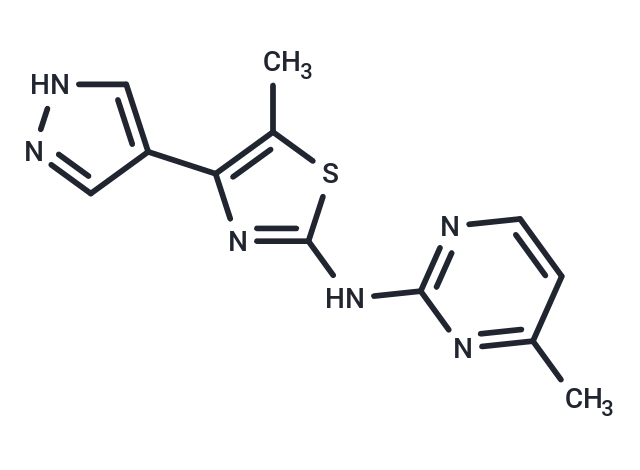Shopping Cart
- Remove All
 Your shopping cart is currently empty
Your shopping cart is currently empty

ADX88178 is a potent positive allosteric modulator for metabotropic glutamate receptor 4 (mGluR4) with EC50 of 4 nM for human mGluR4.

| Pack Size | Price | Availability | Quantity |
|---|---|---|---|
| 2 mg | $32 | In Stock | |
| 5 mg | $53 | In Stock | |
| 10 mg | $88 | In Stock | |
| 25 mg | $158 | In Stock | |
| 50 mg | $255 | In Stock | |
| 100 mg | $373 | In Stock | |
| 200 mg | $532 | In Stock | |
| 1 mL x 10 mM (in DMSO) | $55 | In Stock |
| Description | ADX88178 is a potent positive allosteric modulator for metabotropic glutamate receptor 4 (mGluR4) with EC50 of 4 nM for human mGluR4. |
| Targets&IC50 | mGluR4 (human):4 nM(EC50) |
| In vitro | ADX88178 is used as a novel radioligand for imaging of metabotropic glutamate receptor subtype 4 (mGluR4). ADX88178 potentiates glutamate-mediated activation of human mGluR4 with EC50 values of 4 nM without significant effects on other mGluRs (EC50 > 30 μM). Microglia are pretreated with 1, 10 or 100 nM ADX88178 or 100 nM LAP4 for 30 min followed by LPS treatment for 24 h prior to collecting culture supernatant for ELISA measurement of TNFα levels. The pre-treatment with ADX88178 and LAP4 both significantly attenuate LPS-induced TNFα levels. As little as 1 nM of ADX88178 is sufficient to inhibit TNFα, and is as effective at concentrations of 10 and 100 nM. |
| In vivo | In rats, ADX88178 (10-100 mg/kg p.o.) dose-dependently increases the number of open-arm entries in the rat EPM test. Specifically, at 10, 30, and 100 mg/kg ADX88178, there are 5-, 8-, and more than 10-fold increases in the number of open-arm entries, respectively, when compared with the vehicle-treated controls. Also, ADX88178 dose-dependently increases the time spent in the open arms. Specifically, at 10, 30, and 100 mg/kg ADX88178, there are 7.5-, 11-, and 13-fold increases in time spent in the open arms when compared with the vehicle-treated controls. |
| Kinase Assay | Stability of UAMC00039 in RPMI medium or assay buffer (50 mM cacodylate buffer pH5.5) is monitored at 37 °C. The inhibitors' capacity (IC50) to inhibit DPPII is measured at different time points (up to 48 h). U937 cells are incubated with various concentrations of UAMC00039 for 15 min at 37 °C in RPMI. Cells are then ished with PBS, lysed and assayed for DPPII activity. Concentration–response and time–response curves are generated from incubations of PBMC with UAMC00039 (0.01 nM–1 μM) in RPMI at 37 °C for 1, 5, 15, 30 and 60 min. Ished cells are lysed overnight at 4 °C using 100 mM HEPES buffer pH 7.4, 10 mM EDTA, 70 μg/mL aprotinin and 1% octylglucoside. |
| Cell Research | ADX88178 is dissolved in DMSO and stored, and then diluted with appropriate medium before use. After adhesion to the chamber slides, microglia from WT and mGlu4 KO microglia pre-treated with 1 nM, 10 nM, 100 nM ADX88178, or 100 nM L-AP4. Each treatment is performed in quadruplicate. Thirty minutes after treatment with ADX88178 or L-AP4, 100 ng/mL LPS is added to the cultures and the cells are incubated at 37 °C for an additional 24 h. At the end of the 24 h treatment period, media is collected and analyzed for TNFα, and the cells are for iNOS and MHC II expression by immunocytochemistry. |
| Animal Research | Mice and Rat Male mice (n=8-10/group) are treated orally (p.o.) via gavage with vehicle [1% carboxymethyl cellulose (CMC)], ADX88178 (1, 3, 10 and 30 mg/kg) or Diazepam (1.5 mg/kg). Male rats (n=10/group) are treated p.o. with vehicle (1% CMC), ADX88178 (10, 30, and 100 mg/kg), or Diazepam (3 mg/kg). After 60 minutes, animals are individually placed in the center of the maze (facing one of the closed arms) and left to explore for 5 minutes. A terminal blood sample is collected from all ADX88178-treated animals at the end of the experiment, and plasma is analyzed for the pharmacokinetic studies. The number of open-arm and closed-arm entries, as well as the time (seconds) spent in the open arms of the maze, is analyzed by one-way analysis of variance followed by Dunnett's test. |
| Molecular Weight | 272.33 |
| Formula | C12H12N6S |
| Cas No. | 1235318-89-4 |
| Smiles | Cc1sc(Nc2nccc(C)n2)nc1-c1cn[nH]c1 |
| Relative Density. | no data available |
| Storage | Powder: -20°C for 3 years | In solvent: -80°C for 1 year | Shipping with blue ice. | ||||||||||||||||||||||||||||||
| Solubility Information | DMSO: 22.5 mg/mL (82.62 mM), Sonication is recommended. | ||||||||||||||||||||||||||||||
Solution Preparation Table | |||||||||||||||||||||||||||||||
DMSO
| |||||||||||||||||||||||||||||||

Copyright © 2015-2025 TargetMol Chemicals Inc. All Rights Reserved.